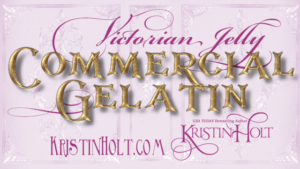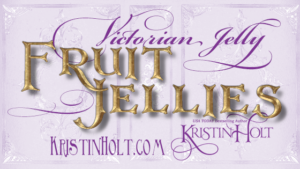Victorian Jelly: Isinglass and Irish Moss too
Victorian Jelly: Isinglass and Irish Moss
.
At the time Victoria was crowned, cooks jellied confections with calves’ feet and ivory dust. Cooks thickened dishes with flour, of course. And isinglass. Irish moss, too. I’d never heard of either.
.
What is Isinglass?
.
An 1842 English paper explains and lists prices.
.

Sources of Isinglass, from The Essex County Standard Etc. of Colchester, England, February 4, 1842.
.
Isinglass, manufactured from the swimming-bladders (also known as sounds) of fish, came primarily from sturgeon. This collagen-rich bladder is dried and prepared for various uses including the fining of beer. Most important to the subject of Victorian Jelly, cooks employed isinglass in gelled dishes.
.
Photos of Isinglass
.

Contemporary photographs of prepared isinglass and shredded isinglass. Photos courtesy of Wikimedia and Renegade Brewing.
.
What is Irish Moss?
.
True to mid-nineteenth century form, this 1852 London article is verbose. And flowery. Apparently the writer loved seaweed and knew his audience did too.
I’ll recap the important bits, below.
.

Sea Weeds as Food, explaining Irish Moss in culinary uses. From Daily News of London, England, September 27, 1852.
.
Various British seaweeds were eaten by humans as salad greens. The same sea vegetation became fodder for both swine and cattle. And fertilized fields, too.
Third paragraph from the end finally explains Irish Moss in context of a sweetened, gelled dish. “A nourishing and easily-digested food for invalids, boiled with milk and sugar, which, when cool, forms a beautiful blancmange.”
.

up next!
.
Photos of Irish Moss
.

Photos of Irish Moss / Carrageen / red algae. Courtesy of Encyclopaedia Britannica.
.
Victorian Isinglass Jelly Recipes
.
Jellies played a primary role in Victorian dessert courses. Housekeepers, hotel cooks, and pastry businesses held jellies in high esteem.
The following image contains four fruit jellies, each made with isinglass. The recipes, in the end, are set in iced moulds and served as dessert.
.

From The Complete Confectioner Pastry-Cook, published 1844: Fruit Jellies: Strawberry Jelly, instructions to clarify Isinglass, Pine Apple Jelly, Jelly of Apricots, and Orange Jelly.
.
The Complete Confectioner Pastry-Cook (above) and Miss Beecher’s Domestic Receipt Book (below), give instructions for clarifying isinglass.
.

To Clarify Isinglass from Miss Beecher’s Domestic Receipt Book, 1846.
.
Miss Catharine Beecher’s 1846 popular recipe book gives several jellies. Traditional flavors include lemon, orange, and wine.
.

Recipe for Isinglass Lemon Jelly, from Miss Beecher’s Domestic Receipt Book, 1846.
.

Lemon Jelly and Orange Jelly recipes, employing isinglass. From Miss Beecher’s Domestic Receipt Book, 1846.
.

Isinglass and Irish Moss. Recipe for American Isinglass Jelly. From Miss Beecher’s Domestic Receipt Book, 1846.
.
Notice Miss Beecher’s Lemon Jellies don’t use egg whites, while her orange does. Many early Victorian-era jelly recipes use egg whites in fining. Victorians loved clear jellies, it is true!
Jaune mange is the only type I’ve seen, so far, that calls for egg yolks. After all, yolks won’t yield clear jelly.
.

Recipe for Isinglass Jaune Mange, from Miss Beecher’s Domestic Receipt Book, 1846.
.
Undoubtedly, soft and sweet foods are good for invalids. Just ask any good Victorian housekeeper. Here, Miss Beecher insists blanc mange is ideal for convalescents.
.

Isinglass for Invalids, from Miss Beecher’s Domestic Receipt Book, 1846.
.
Victorian Irish Moss Recipes
.

Irish Moss Jelly recipe for Consumptives. From Beadle’s Dime Cook Book, 1864.
.
Advertisements: Isinglass and Irish Moss
.
Cooper’s American Isinglass advertised throughout the country in the late 1830s and beyond. Ads emphasized quality and affordability.
.

1 of 2) Advertisements from within the United states, dated July 1838 through January 1847.
.
Montpelier stores sold Irish moss in addition to Cooper’s refined isinglass. Cooper’s ad implies the manufacturing process greatly reduces kitchen work. To be sure, the time-saving article appealed to housekeepers. Compared to cleaning and boiling calves’ feet, yes. I’d buy refined isinglass too.
Richmond stores offered Cooper’s sheet isinglass or shreds (pictured above). And shredded Russian isinglass, as well as “French Gelatine.” I’ll share more about patented “French Gelatine” in my soon-to-come post Victorian Jelly: Commercial Gelatin.
.

2 of 2) Advertisements for Isinglass and Irish Moss, published in the United States between January 1849 and December 1858.
.
The middle ad, above, appeared in 1854 Honolulu. Isinglass, of course. Moreover, a singular item: “Iceland Moss.”
In the last ad, a drug store offered Cooper’s sheet and shred isinglass. And something else–“corn starch for table use.” Earlier (1850) a fellow named Kingsford extracted the germ from corn. Kingsford Corn Starch made a splash in starching laundry, but it wasn’t believed edible. Once accepted for culinary use, corn starch found its place among thickeners.
.
Isinglass and Irish Moss
.
.
Related Articles
.

Victorian Jelly: Blog Post Series ~ a complete series of eight posts
.
Updated July 2022
Copyright © 2021 Kristin Holt LC
Victorian Jelly: Isinglass and Irish Moss

















